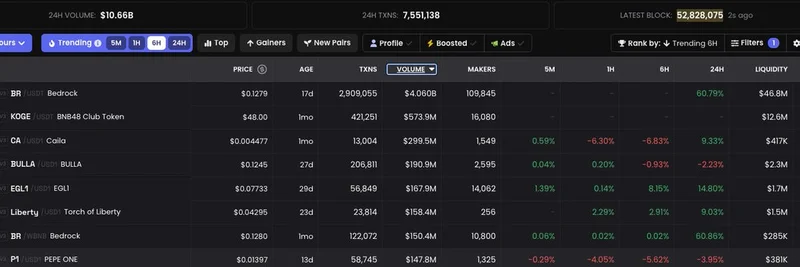If you've been scrolling through crypto Twitter lately, you might have stumbled upon a heated discussion about PancakeSwap and its impressive revenue figures. A tweet from @SweetcheeksReal highlighted how PancakeSwap is raking in more money than Hyperliquid, despite a much smaller market cap. But when investor Jason Choi dug a little deeper, he uncovered something that smells a lot like wash trading—especially in the world of meme tokens.
The Initial Buzz
It all started with a post pointing out PancakeSwap's 30-day revenue of $66.15 million, edging out Hyperliquid's $60.14 million. On paper, that's a win for the multi-chain DEX (decentralized exchange) built on Binance Smart Chain. But Choi, co-founder of Tangent and former GP at The Spartan Group, decided to verify the numbers. What he found? A whopping 40% of PancakeSwap's volume comes from a single token: BR/USDt (Bedrock), a low-cap asset with just $26 million in market cap but supposedly trading $4 billion daily.
That's not just eyebrow-raising—it's a red flag. Wash trading, for those new to the term, is when traders buy and sell the same asset repeatedly to inflate volume figures artificially. It creates the illusion of high activity without real market interest, often to manipulate perceptions or qualify for rewards.
Digging into the Data
Choi shared screenshots from DEXScreener, a popular tool for tracking on-chain trading pairs. The top tokens by volume on PancakeSwap include several meme-inspired ones like KOGE (BNB48 Club Token), CA (Caila), BULLA, EGL1 (EGLi), Liberty (Torch of Liberty), and PEPE ONE. These aren't your blue-chip cryptos; they're volatile, community-driven meme tokens that thrive on hype and speculation.
Look closer at BR/USDt: Its chart shows sporadic spikes in volume that don't align with price movements or broader market trends. The token's age is just 17 days, yet it's dominating the leaderboard. Replies to Choi's thread suggest this could tie back to Binance Alpha's airdrop campaigns, where projects pay in tokens for exposure, and users farm points by trading on platforms like PancakeSwap.
One commenter noted that Binance Alpha runs overlapping campaigns, incentivizing trades with rewards. This could explain the inflated volumes—users churning trades to earn airdrops, not because of genuine interest in the memes.
Implications for Meme Token Traders
For blockchain practitioners and meme token enthusiasts, this raises important questions. Meme tokens like PEPE ONE (a spin on the iconic PEPE frog meme) or Liberty (evoking patriotic themes) are all about community and virality. But when volumes are potentially faked, it distorts the market. Traders might chase "hot" tokens based on misleading data, only to get rekt when the wash trading stops.
PancakeSwap itself burns a portion of fees (13% annually, per one reply), which could benefit holders if the volume is legit. But if it's mostly from campaigns, sustainability is a concern. As Choi put it, he closed the tab and hit the gym—sometimes, the best move is to step back and reassess.
What This Means for the Broader Ecosystem
This isn't isolated to PancakeSwap. Wash trading plagues many DEXs, especially in the meme token space where low liquidity amplifies manipulations. Tools like DEXScreener help spot anomalies, but always DYOR (do your own research). If you're trading memes on BSC, keep an eye on transaction counts, maker diversity, and liquidity pools to gauge real activity.
In the end, while PancakeSwap's revenue looks strong, the underlying story might be more about clever campaigns than organic growth. For meme insiders, it's a reminder: Not all volume is created equal. Stay vigilant, and maybe follow Choi's lead—gains in the gym might be more reliable than some crypto trades.


